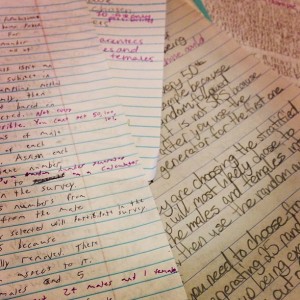I just spent about 80 minutes grading the first AP Stat homework assignment for one class period.1 It may sound painful,2 but it was honestly a bit refreshing. As much as the students need to get back into the swing of doing homework, I feel like I need to get back into the swing of reading / critiquing / grading it as well.
I like to refer to each year of teaching as a “season” — like a season of a television show.3 My second full year in 2008-09 was “season 2”4 (my first half-year in the spring of 2007 was “season 0”).
I didn’t always grade homework for correctness.
Up through the first six weeks of Season 2, I gave mostly “completion” grades for homework — I reserved meaningful written feedback for quizzes, which would hopefully be helpful before getting to the major exams. When it became clear to me that holding students to the expectation that homework needed to be practiced correctly, I started grading about a half-dozen “randomly”5 selected problems on each assignment. I remember when I first started grading homework, it felt impossibly time-consuming and torturous, and that I didn’t think I was going to make it through the end of the week — and at the time, I was only really grading homework for 2 periods of Pre-AP Algebra II.
Students hate it, of course, because they like their homework grades to be easy 100’s. But I found that it was worthwhile,6 as it seemed that students7 started taking their “practice” a little more seriously. More importantly, though, it makes you more aware of the little things to re-emphasize and point out in class the next day, before getting to the next “game day” — a.k.a., the big unit assessments. This is especially important in a class like AP Stat, where nailing the proper specifics in your written responses is of utmost importance.
Which, by the way, if you’re a math teacher8 and are considering teaching AP Statistics, you should know… it encompasses a LOT of writing on the part of the students. I enjoy the reading and writing that is involved, but grading papers is appropriately time-consuming. For reference: I used to be able to knock out a class period of Precalculus tests in about 20 to 30 minutes. A single class set of AP Stat exams, on the other hand, generally takes me about 80 – 100 minutes9 — and that’s if I am working quickly.10 And with it being a class with that big exam at the end, there are no shortcuts — you have to force the students to practice writing, and you have to grade their responses on a regular basis.
A friend of mine once asked me if I “liked” grading papers. Knowing that he had two kids, I looked back at him and replied,
Do you ‘like’ changing diapers?
We both laughed, but… it fits. =)
- it took about the length of one college football game to get through two classes worth [↩]
- actually… it was [↩]
- and each “season” gets a title that I consider appropriate [↩]
- and I gave it the name “Redemption”, for reasons which I may discuss another day [↩]
- probably more of a convenience sample, if you want to be technical [↩]
- as long as you’re not grading to be petty [↩]
- at least some of them! [↩]
- or are aspiring to be one [↩]
- so multiply by the number of class periods… yeah. [↩]
- which by the way, “working quickly” and “rushing through your work” are two very distinct things [↩]


